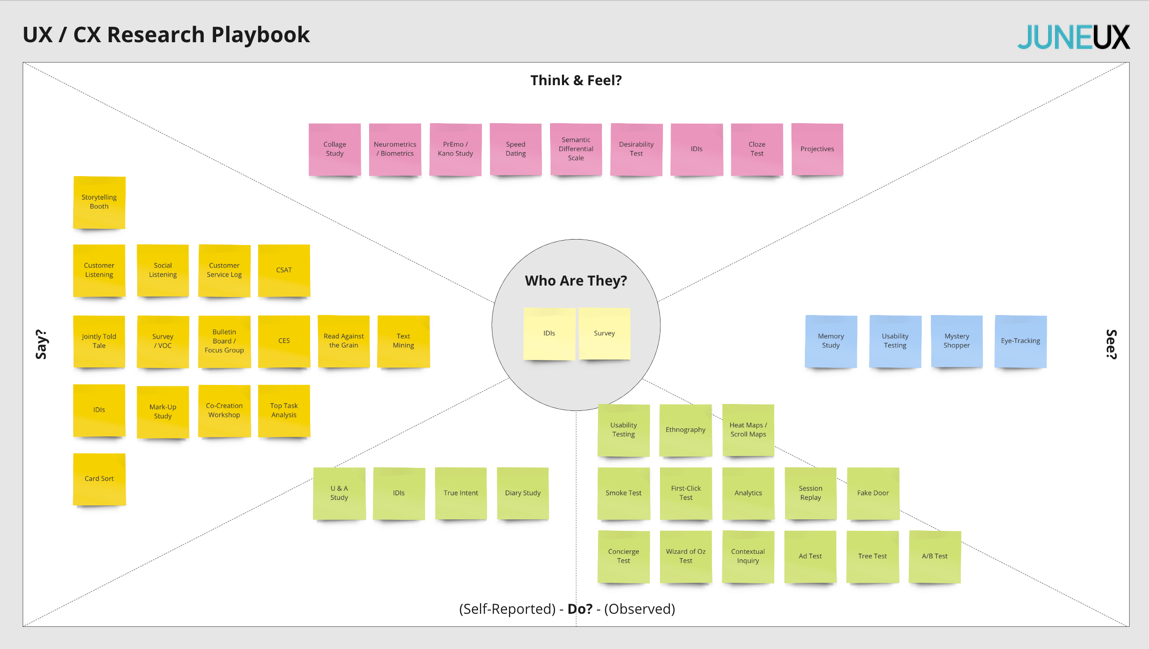With more than 90 UX research methods and techniques available, when or where in the design process is the best place to use them?
What does your organization or team want to learn more about? There are several different methods to consider—depending on your research goal.
- Discovery & problem exploration
- User behaviors
- Navigation
- Content or labeling
- Design
- Usability or concept evaluation
- Emotional response
- UX / CX metrics
- Innovation
UX / CX Research Playbook

Discovery & Problem Exploration
Research goal:
- To discover unknown customer pain points or barriers that your product or organization might be able to solve.
- To gain a deeper understanding of a known customer pain point, barrier, current state experience, user preferences, etc.
UX research methods for discovering or exploring CUSTOMER PROBLEMS:
- Collage study
- Contextual inquiry
- Customer listening
- Customer service log
- Diary study
- Ethnography
- In-depth interviews (IDIs)
- Jointly told tale
- Search log
- Storytelling forum / booth
- Survey / VOC
User Behaviors
Research goal:
- To better understand how your customers think and behave.
UX research methods for observing user BEHAVIORS:
- Web analytics
- Search log analysis
- Customer listening
- User session replay
- Contextual inquiry
- Ethnography / field study
- Big data analysis
- Text mining
- Social listening
- Sensors / lasers
- Video tracking
- IoT analytics
- Private community
- Lifestyle community
Navigation
Research goal:
- To discover user priorities.
- To determine the best design way to organize information.
- To evaluate current or proposed navigation structure.
UX research methods for designing or evaluating NAVIGATION:
- Top task analysis
- Open or closed card sort
- Tree test
- Usability study
- Survey
Content or Labeling
Research goal:
- To evaluate the effectiveness of the content.
UX research methods for evaluating CONTENT:
- Readability test
- Cloze test
- Usability study
- Tone of voice pairs
- Read against the grain
- SUPR-Q
Research goal:
- To evaluate the effectiveness of labels.
UX research methods for evaluating LABELS:
- Tree test
- Closed card sort
- Usability study
Design
Research goal:
- To evaluate the aesthetics / visceral impact of the design.
- To evaluate the effectiveness of the design and layout.
UX research methods for evaluating DESIGN:
- Desirability test
- Usability study
- 5-second memory test
- A/B test
- Heat map
- Scroll map
- Eye-tracking study
- Facial analysis
- SUPR-Q
- Taguchi
Usability or Concept Evaluation
Research goal:
- To evaluate the user flow, usability, findability, or task completion rates.
UX research methods for evaluating USABILITY:
- Usability study
- Closed card sort
- Tree test
- A/B test
- First-click test
Research goal:
- To evaluate an idea or concept.
UX research methods for evaluating CONCEPTS:
- A/B test
- Concept study
- Concierge test
- Conjoint analysis
- Fake door test
- Kano
- Mark-up study
- MaxDiff
- Speed Dating
- Taguchi
- Virtual reality study
- Wizard of oz test
Emotional Response
Research goal:
- To evaluate the emotional response to a product, feature, or concept.
UX research methods for uncovering or measuring EMOTIONS:
- 3E (Expressing Experiences & Emotions)
- Affect grid / EmojiGrid
- Biometrics
- Emotrak
- ESM Study (Experience Sampling Method)
- FACS (Facial Action Coding System)
- Kano
- Neurometrics
- Product Emotion Measurement (PrEmo) / EmoCards
- Projectives (e.g., blob tree)
- SAM (Self-Reported Manikin)
- Semantic Differential Scale
UX / CX Metrics
Research goal:
- To evaluate the effectiveness of the user experience.
- To benchmark performance over time or against competitors.
UX metrics for measuring PERFORMANCE:
- CES
- CSAT
- SEQ
- SUS
- True intent
- Mystery shopper
- Web analytics
- Heat map
- SCI
- Scroll map
- SUPR-Q
- Time on task
- Task completion rate
Innovation
Research goal:
- To find the next big idea.
UX research methods for discovering INNOVATIVE IDEAS:
- Customer listening
- Customer workshop / co-creation workshop
- Diary study
- Private community / bulletin board
- Ethnography / field study
- In-depth interviews (IDIs)
- Social listening
- Speed dating
Related Articles
- Discovering Hidden Insights with Kano Analysis: A Case Study
- ESAT & CSAT: A Survey Alignment Love Story
- UX Research Toolbox: Anatomy of a Compelling Narrative for Your UX Research Reports
- Data Overload? How to Manage the Flow of CX Insights Effectively
- Bias-Free UX Research: Innovative Approaches to Mitigating Bias in the Research Process